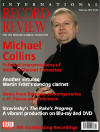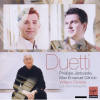Texte paru dans: / Appeared in:
*

International Record Review - (02/2012)
Pour
s'abonner / Subscription information
Virgin Classics
07094323

Code-barres / Barcode:
5099907094323
Consultez toutes les évaluations recensées pour ce cd
~~~~ Reach all the evaluations located for this CD
There are other records of duets by
countertenors, but few discs (LP or CD) include no further voices. I have no
intention of spending space on whether a correct designation is
countertenor, male alto or sopranist. The first occasion on which I heard
the combination of two such voices came years ago on my newly acquired
L’Oiseau-Lyre LP of Purcell’s Come ye sons of art, with Aifred Deller
and John Whitworth in that lovely duet ‘Sound the trumpet’. Nothing as
well known appears in this programme from Max Emanuel Cencic and Philippe
Jaroussky.
What is put before us is a selection of Italian chamber duets (nothing operatic) and two solo cantatas. Some four works are complete, with duets extracted from four others. The informative notes of Susanne Kessler are helpful. In Bononcinis Pietoso nume arcier, which opens the disc, the outer duets find the two voices in tandem, but the central recitative enables the listener to hear each singer on his own. The second duet, ‘Se l’idolo che adoro’, would be testing enough for a singer in a solo, but for two to keep in time through the dazzling scalework is a feat of wonderful vocal dexterity, and how well Cencic and Jaroussky work together. The first of a pair of duets from Bononcini’s Chi d’amor tra le catene is of a doleful countenance, likening loves snares to a pit of woe, but how beautifully the two soloists blend.
The Porpora work is a cantata for voice and violins, with Cencic supplying the former. Its first aria has ornate vocal curlicues replete with many trills, while for the second Porpora goes even further in his rapid passagework, over which Cencic darts scintillatingly with a virtuosity that is breathtaking, though he manages to produce enough breath for the long divisions. Much as I love Deller’s singing, I know nothing on records which indicates that he could have sung at this speed. In similar vein is the second aria in Mancini’s cantata, drawing from Jaroussky a vivid display of polished technique, whereas he traces a calmer line in the opening aria, under which the instrumentalists from Les Arts Florissants suggest the rippling stream.
The longest item on the CD is Marcello’s Chiaro e limpido fonte at just over 18 minutes, containing four recitatives, two arias (one for each singer) and two duets. Silvio and Mirtillo are saddened by the departure of Livia, whom both of them love. The first duet is a lament in which the two voices complement each other, with Cencic’s warm middle tones supporting the brighter timbre of his colleague as they slowly merge and diverge.
Three further duets extracted from complete works bring another composition by Marcello: ‘Veggio Fille/Parlo a Clori’. It is a slow, beautifully sculptured piece in which the voices twine around each other but in a sedate manner, gorgeously performed by Cencic and Jaroussky. Following it with markedly different tempo is Scarlatti’s ‘Nel cor del cor mio’.
One duet that I thought especially delightful (indeed, crammed with delights) is ‘Quando veggo un’usignolo’ from Conti’s cantata of the same title. In this, the voices begin separately, then come together and the pattern alternates in eight minutes of sheer enchantment. Again Cencic and Jaroussky exhibit their skill in stepping through the embellished line so precisely. Clori (Jaroussky) takes the higher line, reflecting, perhaps, that to her the nightingale’s song sounds joyful whereas Irene finds it one of sadness. I should like to hear the s cantata.
It should not take long to differentiate between the two singers, for usually Jaroussky is, as it were, the soprano to the mezzo of Cencic. Their respective abilities in producing their tone and dispatching it through the intricate music are on a par with each other.
The five instrumentalists (Elizabeth Kenny plays both the theorbo and the lute, with William Christie at the harpsichord and the organ) make attractive sounds, adding to the pleasure given by the singers. When one reads in the notes how many cantatas were written by these composers and some of their contemporaries, one assumes that among them will be a number of duets similar to those appearing on this welcome disc.
Cliquez l'un ou l'autre
bouton pour découvrir bien d'autres critiques de CD
Click either button for many other reviews


